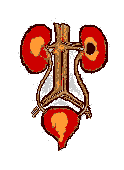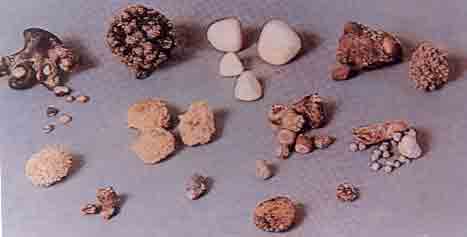|
|
|
 |
 |
 |
Common Kidney Stones in India.
|
Urinary Stone Disease
Urinary stones have been with human beings since ages. The disease has remained persistent ,but the treatment has changed completely over the last two decades.We have come a long way from the time when a person was treated using a long rib cutting grotesque incision for even small stones. Today, more than 95% of patients can be relieved of their problem without resorting to an open operation.
Is this disease common?
Stone disease is quite common. A recent study has estimated that 1 - 5% of the population of the industrialized countries might have stone disease. Stones are more frequent in hot tropical areas such as India.
Where are stones formed?
Stones may form anywhere in the urinary tract including the kidney, ureter or bladder. The stones are formed from calcium, phosphate or urate compounds that are normally dissolved in the urine. They vary in size and may be single or multiple.
What causes stone formation?
Although the exact cause of kidney stones is unknown, possible contributing factors include decreased urine production, infection, urinary obstruction, defects in the body's metabolism of certain substances and excessive intake of vitamin D or dietary calcium. A simple concept of stone formation is that stones result from a chemical reaction that occurs when the urine becomes too concentrated. Calcium salts, uric acid, cystine and other substances in the urine crystallise to form a hard mineral deposit , often the size of a small pebble.
The following are the most common kidney stones in India.
Calcium Stones: These account for 75%-85% of all stones and are common in men. These are stones formed by Calcium combining with Oxalate or Phosphate.
Uric Acid Stones: These account for 8% of all stones. These are particularly likely if the output of Uric acid is large,as in some patients with Gout, where the urine remains very acidic and the volume of urine is very small.
Cystine Stones: These stones form in persons who have the hereditary disorder Cystinuria. Men and Women are equally likely to have cystine stones. These account for only 1% of all stones.
Struvite Stones: These are mainly found in women. These are formed due to bacterial urinary tract infection. These stones can grow very large, producing the appearance of a stag's horn. They can obstruct the urinary tract and cause damage to Kidney.
How do I know that I have stone disease ?
Urinary stone is a very common problem. Symptoms may vary according to the size and location of the stone. Patients harbouring a stone may have a severe flank pain which radiates to the upper abdomen, Inguinal area or the Genitals. This pain can be very severe. Rarely there may be just a dull persistent backache. Apart from pain,few patients may pass blood in Urine. Some may have burning in Urine or unexplained fever. Some patients may not have any symptoms. These 'unlucky' patients are accidentally diagnosed during an X-Ray or Sonography for some other reason. In these patients the stones may lie undetected for a long time. The stone may grow to a large size. Treatment then becomes difficult. The stone also gradually damages the Kidney.
Can Stones damage the Kidney ?
Yes, stone sometimes destroy the Kidney by blocking the Urinary passage and causing back pressure on the Kidney. They also act as a source for repeated infections. This leads to a gradual damage of the kidney.
Remember, Stones should never be Neglected !!
Stones, irrespective of their size or position, should be either treated or kept under doctor's observation.